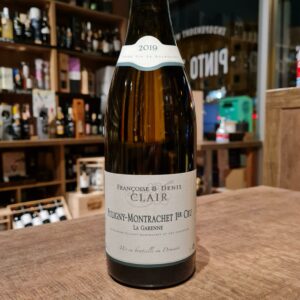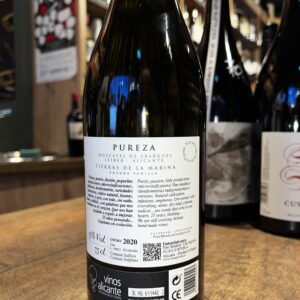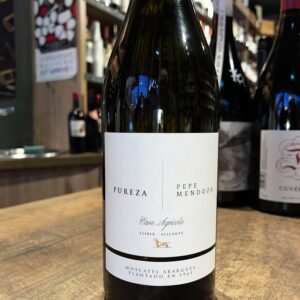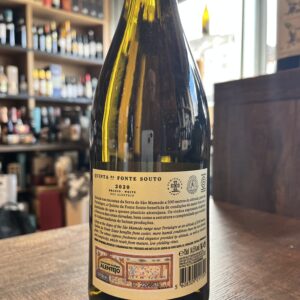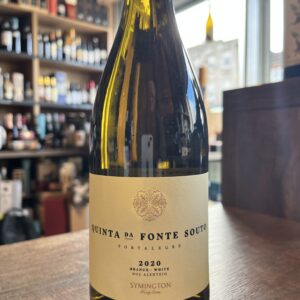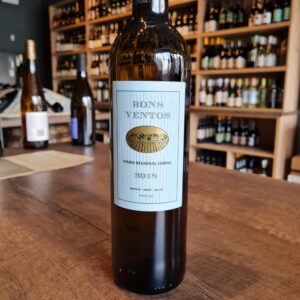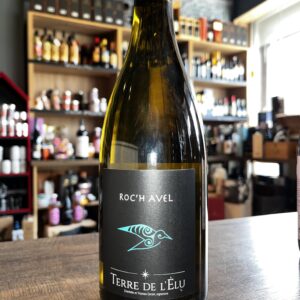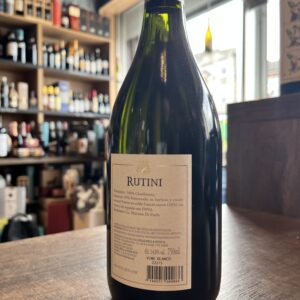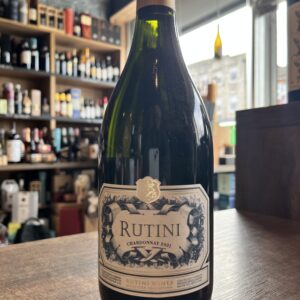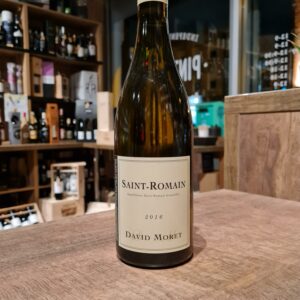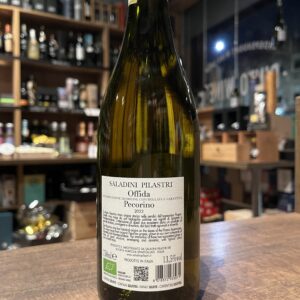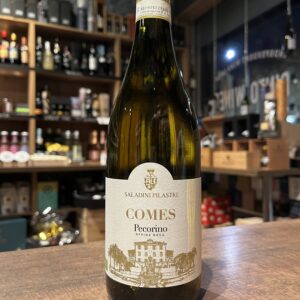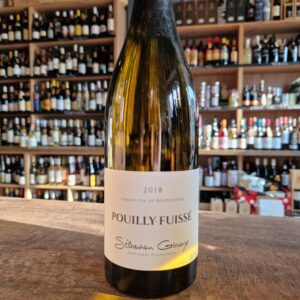-
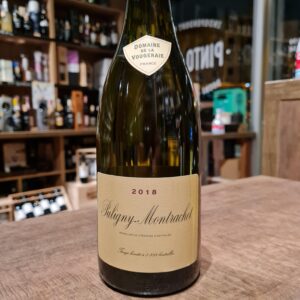 Domaine de La Vougeraie is born from the assembly of domains acquired over time and the vines of the family. Its history dates back to 1964 with the first vine, Les Evocelles, acquired by our father at his very beginnings. Here, it is in his village that he will have his first lands around Gevrey-Chambertin. The reputation of Domaine de la Vougeraie is well established. This area of excellence is located in Premeaux-Prissey, a small village in Burgundy , near Nuits-Saint-Georges, in the Côte de Nuits . For this cuvée, the estate brings together two small plots in the “ La Rue aux Vaches ” and “ Noyer Bret ” climates . They are planted with Chardonnay and worked in biodynamics , homeopathy applied to the vine. 2018 was a generous, sunny vintage, which managed to maintain a good level of freshness Sylvie Poillot, General Manager, farms the estate’s 42 hectares biodynamically. “We do this to preserve the fertility of soils, and to have a very good balance between the soil and the plant’s health,” she explains. It’s not just the soil health that’s changed: two decades on from their conversion to biodynamics, the wines are evolving too: “The wines are more aromatic and more expressive year after year,” she says. A fascinating 2018: on the one hand, it’s opulent with the warmth of the vintage; on the other, it’s tight with typical Puligny fruit, stone and bite. A superior example. Drink 2022-2028 Great with grilled fish, scallops, lobster, lobster
Domaine de La Vougeraie is born from the assembly of domains acquired over time and the vines of the family. Its history dates back to 1964 with the first vine, Les Evocelles, acquired by our father at his very beginnings. Here, it is in his village that he will have his first lands around Gevrey-Chambertin. The reputation of Domaine de la Vougeraie is well established. This area of excellence is located in Premeaux-Prissey, a small village in Burgundy , near Nuits-Saint-Georges, in the Côte de Nuits . For this cuvée, the estate brings together two small plots in the “ La Rue aux Vaches ” and “ Noyer Bret ” climates . They are planted with Chardonnay and worked in biodynamics , homeopathy applied to the vine. 2018 was a generous, sunny vintage, which managed to maintain a good level of freshness Sylvie Poillot, General Manager, farms the estate’s 42 hectares biodynamically. “We do this to preserve the fertility of soils, and to have a very good balance between the soil and the plant’s health,” she explains. It’s not just the soil health that’s changed: two decades on from their conversion to biodynamics, the wines are evolving too: “The wines are more aromatic and more expressive year after year,” she says. A fascinating 2018: on the one hand, it’s opulent with the warmth of the vintage; on the other, it’s tight with typical Puligny fruit, stone and bite. A superior example. Drink 2022-2028 Great with grilled fish, scallops, lobster, lobster -
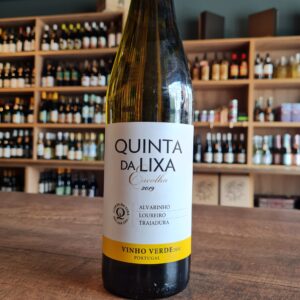 This wine is made from the noblest and best known Portuguese grape variety(Alvarinho), in a year of exceptional quality. The aroma is intense and very attractive, with flowery and fruity notes, and lemonade hints, in a combination of great character and fineness. Tropical fruit in the mouth, acidity fits nicely with the fruit. Long finish
This wine is made from the noblest and best known Portuguese grape variety(Alvarinho), in a year of exceptional quality. The aroma is intense and very attractive, with flowery and fruity notes, and lemonade hints, in a combination of great character and fineness. Tropical fruit in the mouth, acidity fits nicely with the fruit. Long finish -
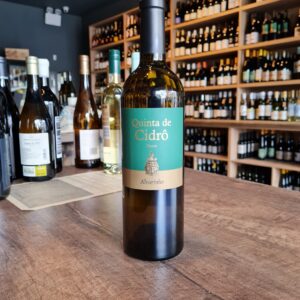 Quinta de Cidrô presents the first Alvarinho produced in the Douro, another superb result of the continuous innovation that takes place in the vineyards of the property. The idea to plant Alvarinho in the Douro came from their ambition to produce a high quality white monovarietal from a Portuguese grape variety. A wine marked by fine and delicate aromas of citrus fruit and orange blossom, which presents an excellent aromatic complexity. Expressive and personalized, it is above all a full-bodied Douro wine, revealing flavours that can be guessed at in the aroma. A long and distinct Alvarinho, determined by a crisp acidity and a tasty minerality.
Quinta de Cidrô presents the first Alvarinho produced in the Douro, another superb result of the continuous innovation that takes place in the vineyards of the property. The idea to plant Alvarinho in the Douro came from their ambition to produce a high quality white monovarietal from a Portuguese grape variety. A wine marked by fine and delicate aromas of citrus fruit and orange blossom, which presents an excellent aromatic complexity. Expressive and personalized, it is above all a full-bodied Douro wine, revealing flavours that can be guessed at in the aroma. A long and distinct Alvarinho, determined by a crisp acidity and a tasty minerality. -
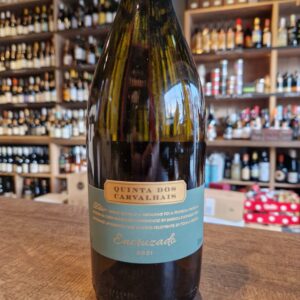 Sogrape Vinhos was founded in 1942 by Fernando van Zeller Guedes, with the ambition of making Portuguese wines known to the world and a long-term vision based on the quality of the wines to be marketed, the importance of the novelty of the brands, and the presentation of its wines. Today, led by the third generation of the founding family, Sogrape Vinhos is increasingly faithful to the goal it has had since it was founded: to be a family-owned company with an international vocation, focused on the production of quality wines, on innovation, and the development of global Portuguese brands. Sogrape Vinhos has about 830 hectares of vineyards in Portugal. Quinta dos Carvalhais is located in the municipality of Mangualde, near Nelas and Alcafache. The soil, the climate, the experience of those who have always produced wine make the Dão truly special. This 105-hectare estate, situated at an altitude of 465-500 metres, has 50 hectares under vine on predominantly granite soils. Warm days and cool nights at this altitude slow down the grape ripening process and result in wines with lovely depth yet vibrant fruit and a signature freshness. Precision viticulture is carried out on the estate with a multitude of different plots matched to specific grape varieties and harvested at different times. The fruit for the 2021 Encruzado was sourced from four different plots. Two cooler plots, one next to the lake on the estate and another often shaded by the oak trees, deliver a vibrant acidity the blend. Another plot with more sandy soils produces intensely aromatic grapes. All of the vineyards are farmed sustainably and harvesting is carried out by hand.
Sogrape Vinhos was founded in 1942 by Fernando van Zeller Guedes, with the ambition of making Portuguese wines known to the world and a long-term vision based on the quality of the wines to be marketed, the importance of the novelty of the brands, and the presentation of its wines. Today, led by the third generation of the founding family, Sogrape Vinhos is increasingly faithful to the goal it has had since it was founded: to be a family-owned company with an international vocation, focused on the production of quality wines, on innovation, and the development of global Portuguese brands. Sogrape Vinhos has about 830 hectares of vineyards in Portugal. Quinta dos Carvalhais is located in the municipality of Mangualde, near Nelas and Alcafache. The soil, the climate, the experience of those who have always produced wine make the Dão truly special. This 105-hectare estate, situated at an altitude of 465-500 metres, has 50 hectares under vine on predominantly granite soils. Warm days and cool nights at this altitude slow down the grape ripening process and result in wines with lovely depth yet vibrant fruit and a signature freshness. Precision viticulture is carried out on the estate with a multitude of different plots matched to specific grape varieties and harvested at different times. The fruit for the 2021 Encruzado was sourced from four different plots. Two cooler plots, one next to the lake on the estate and another often shaded by the oak trees, deliver a vibrant acidity the blend. Another plot with more sandy soils produces intensely aromatic grapes. All of the vineyards are farmed sustainably and harvesting is carried out by hand. -
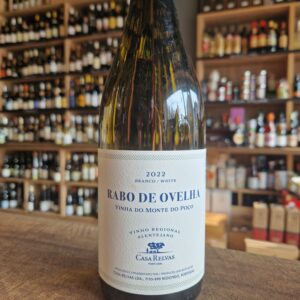 Casa Relvas is a family project, started in 1997 in São Miguel de Machede, in Redondo, by Alexandre Relvas, which aims to continue the history of five generations with a strong passion for the Alentejo and its genuine nature. Over the years, the family has grown along with the business and it didn't take long for it to total about 750 hectares of Montado forest, 225 hectares of olive groves, and 350 hectares of 100% integrated production vineyards. With the three estates - Herdade de São Miguel, Herdade da Pimenta and Herdade de São Miguel de Machede - Casa Relvas has the capacity to produce 6 million bottles of wine annually, 70% of which is to meet the needs of the foreign market, being present in over 30 countries worldwide, offering the best of the Alentejo.
Casa Relvas is a family project, started in 1997 in São Miguel de Machede, in Redondo, by Alexandre Relvas, which aims to continue the history of five generations with a strong passion for the Alentejo and its genuine nature. Over the years, the family has grown along with the business and it didn't take long for it to total about 750 hectares of Montado forest, 225 hectares of olive groves, and 350 hectares of 100% integrated production vineyards. With the three estates - Herdade de São Miguel, Herdade da Pimenta and Herdade de São Miguel de Machede - Casa Relvas has the capacity to produce 6 million bottles of wine annually, 70% of which is to meet the needs of the foreign market, being present in over 30 countries worldwide, offering the best of the Alentejo. -
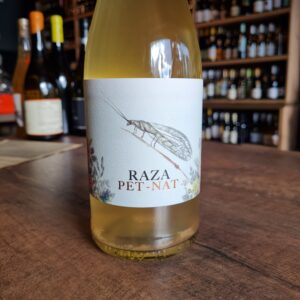 The concept of this label is to send the consumer to the botanical universe of the XVI century. A very unique style which is a tribute to nature and the living beings who look after it so well. A mixture of charcoal pencils with watercolor provides fresh, traditional, and natural air. The informative label on the side of the bottle is drawn in a vintage style referencing this era's aesthetics. The Lacewing or Chrysoperla (Raza)represents their holistic approach to viticulture. Its efficiency in biological control pest is remarkable and helps keep the vines free of pests.Pet Nat is an abbreviation for Pétillant Naturel, a naturally sparkling wine. The fermented wine is still bottled in the bottle, which stops the fermentation there, so a little CO2 and yeast precipitate is formed in the bottle. The wine is not cleaned, sweetened (no dosage) and the wine is now closed with a regular crown cap. The wine is made with natural yeast and uses minimal sulphites. Spontaneous fermentation ends in the bottle, as a result of which a pleasantly natural layer remains in the wine. This refreshing, sparkling wine is full of fruity and lively orchard flavors. The natural sediment makes the wine cloudy, while adding many interesting nuances to the taste, the wild yeast makes the wine tasty and easy to enjoy.
The concept of this label is to send the consumer to the botanical universe of the XVI century. A very unique style which is a tribute to nature and the living beings who look after it so well. A mixture of charcoal pencils with watercolor provides fresh, traditional, and natural air. The informative label on the side of the bottle is drawn in a vintage style referencing this era's aesthetics. The Lacewing or Chrysoperla (Raza)represents their holistic approach to viticulture. Its efficiency in biological control pest is remarkable and helps keep the vines free of pests.Pet Nat is an abbreviation for Pétillant Naturel, a naturally sparkling wine. The fermented wine is still bottled in the bottle, which stops the fermentation there, so a little CO2 and yeast precipitate is formed in the bottle. The wine is not cleaned, sweetened (no dosage) and the wine is now closed with a regular crown cap. The wine is made with natural yeast and uses minimal sulphites. Spontaneous fermentation ends in the bottle, as a result of which a pleasantly natural layer remains in the wine. This refreshing, sparkling wine is full of fruity and lively orchard flavors. The natural sediment makes the wine cloudy, while adding many interesting nuances to the taste, the wild yeast makes the wine tasty and easy to enjoy. -
 For those red wine lovers. You know what I mean by red lips! We brought together for you a red wine case of 6 bottles full of character, lavish richness, booming dark fruits, warming spice flavours, and velvet-smooth down to the very last drop. With this case you will travel from Portugal, Spain through France and Italy all the way to California. No doubt you will develop some red wine lips... Lab Tinto Lisboa - Lab tested and Lab approved! Full bodied, red produced on the coast of Lisbon, is smooth and is very aromatic with notes of ripe black and red fruits. On the palate, juicy plums and dark berry fruit flavour with plenty of fresh yet fine tannins that take over at the finish, along with flavours of spice and liquorice. It is not a top shelf wine but it does punch above its weight. Michel Chapoutier Marius - As Marius, Michel Chapoutier’s great-grandfather, always said ‘A good wine is one that beckons us to take another sip’. This wine carries this message and reflects the warmth of the southern french terroirs in which they are rooted. Dark red, dense, clear wine with deep purple shimmer. On the nose: powerful, complex, dark, spicy, red berries, delicate floral note. Château Haut Gravelier - Château Gravelier is located on superb hillsides on the edge of Entre Deux Mers, Bordeaux. Classic French blend of 70% Merlot 30% Cabernet Sauvignon. With deep colour, classic structure and unusually ripe flavours, this is classic claret to serve with roast beef, duck or T-bone steak. Palacio del Camino Crianza Rioja - The simple enjoyment of a really good Rioja is sometimes forgotten. But here one is, great with food, but honestly, just as great in a large glass on a sofa with nowhere to be and nothing to do. An elegant fruity wine with vanilla, spices and red fruit. Monte del Frá Bardolino DOC - This charming and typical red wine from Veneto is a cuvée made from 65% Corvina, 30% Rondinella and 5% Sangiovese, the usual suspects as Italian red grape varieties go. On the nose exudes aromas of different types of cherries, raspberries and strawberries. A whole range of spicy overtones and undertones play around this fruity core: cloves, cinnamon, violets and pepper. Tannins and fruit acid are perfectly coordinated. In the finale, some more cinnamon and black pepper. I would pair this one with pasta or your favourite comfort food. Beringer Zinfandel California - A Zin that definitely portrays some Classic California ripeness. Ripe blueberries, blackberries, plums, a hint of smoky and mineral characters and a touch perfumed (dried floral notes) on the nose. On the palate you'll find that smoke and berry ripeness coming through, with a little tangy raspberry adding to a lengthy finish. Medium plus body with a silky mouthfeel, smooth light tannins and luscious acidity. I love Zins with a juicy bacon and smoked cheddar burger or with your favourite pizza. This one should not disappoint!
For those red wine lovers. You know what I mean by red lips! We brought together for you a red wine case of 6 bottles full of character, lavish richness, booming dark fruits, warming spice flavours, and velvet-smooth down to the very last drop. With this case you will travel from Portugal, Spain through France and Italy all the way to California. No doubt you will develop some red wine lips... Lab Tinto Lisboa - Lab tested and Lab approved! Full bodied, red produced on the coast of Lisbon, is smooth and is very aromatic with notes of ripe black and red fruits. On the palate, juicy plums and dark berry fruit flavour with plenty of fresh yet fine tannins that take over at the finish, along with flavours of spice and liquorice. It is not a top shelf wine but it does punch above its weight. Michel Chapoutier Marius - As Marius, Michel Chapoutier’s great-grandfather, always said ‘A good wine is one that beckons us to take another sip’. This wine carries this message and reflects the warmth of the southern french terroirs in which they are rooted. Dark red, dense, clear wine with deep purple shimmer. On the nose: powerful, complex, dark, spicy, red berries, delicate floral note. Château Haut Gravelier - Château Gravelier is located on superb hillsides on the edge of Entre Deux Mers, Bordeaux. Classic French blend of 70% Merlot 30% Cabernet Sauvignon. With deep colour, classic structure and unusually ripe flavours, this is classic claret to serve with roast beef, duck or T-bone steak. Palacio del Camino Crianza Rioja - The simple enjoyment of a really good Rioja is sometimes forgotten. But here one is, great with food, but honestly, just as great in a large glass on a sofa with nowhere to be and nothing to do. An elegant fruity wine with vanilla, spices and red fruit. Monte del Frá Bardolino DOC - This charming and typical red wine from Veneto is a cuvée made from 65% Corvina, 30% Rondinella and 5% Sangiovese, the usual suspects as Italian red grape varieties go. On the nose exudes aromas of different types of cherries, raspberries and strawberries. A whole range of spicy overtones and undertones play around this fruity core: cloves, cinnamon, violets and pepper. Tannins and fruit acid are perfectly coordinated. In the finale, some more cinnamon and black pepper. I would pair this one with pasta or your favourite comfort food. Beringer Zinfandel California - A Zin that definitely portrays some Classic California ripeness. Ripe blueberries, blackberries, plums, a hint of smoky and mineral characters and a touch perfumed (dried floral notes) on the nose. On the palate you'll find that smoke and berry ripeness coming through, with a little tangy raspberry adding to a lengthy finish. Medium plus body with a silky mouthfeel, smooth light tannins and luscious acidity. I love Zins with a juicy bacon and smoked cheddar burger or with your favourite pizza. This one should not disappoint! -
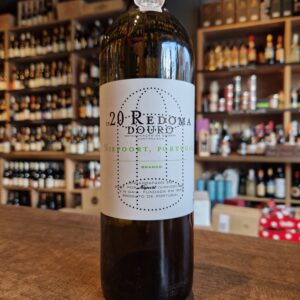 This oaky white will appeal to Graves or Burgundy lovers. The grapes used for the Redoma Branco originate from old vines growing on the right bank of the Douro River, at an altitude of between 400 and 600 metres. These vines predominantly grow in mica-schist soils, which, in combination with the complexity of the various grape varieties typical of the Douro region, create delicate wines full of freshness and minerality. Food suggestions-Oysters, oven-baked fish, poultry and other white meats. Vegetarian options: dishes based on root vegetables (turnips, sweet potato, beetroot), Caesar salad, cheese.
This oaky white will appeal to Graves or Burgundy lovers. The grapes used for the Redoma Branco originate from old vines growing on the right bank of the Douro River, at an altitude of between 400 and 600 metres. These vines predominantly grow in mica-schist soils, which, in combination with the complexity of the various grape varieties typical of the Douro region, create delicate wines full of freshness and minerality. Food suggestions-Oysters, oven-baked fish, poultry and other white meats. Vegetarian options: dishes based on root vegetables (turnips, sweet potato, beetroot), Caesar salad, cheese. -
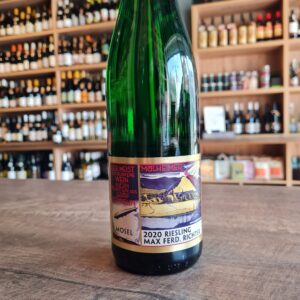 Max Ferdinand Richter winery produces this classic off-dry Mosel Riesling from the Mulheimer Sonnenlay vineyard. The bottle features a beautiful Art Deco label depicting the Zeppelin airships upon which this Riesling was served in the 1920's and 30's. "The Mülheimer Sonnenlay is the largest single Richter vineyard and the source of the world-renowned “Zeppelin” Riesling. The vineyard sits on the west-southwestern side of a slate stone hill south of Mülheim, a dry riverbed formed during the last ice age 250,000 years ago. The name of the vineyard– Sonne (sunshine) and lay (slate stone) –perfectly describes the characteristics of the site. This often extremely steep vineyard has a loose slate stone soil structure that is enriched by pebbles, loam and sand deposited by the ancient river. This kind of soil creates wines that combine typical slate stone mineral character with animated and elegant fruitiness." When possible, they utilize natural yeasts and eschew chemical fining agents. Max Ferdinand Richter’s 48 steep acres are spread out in the Middle Mosel Valley between Erden and Brauneberg. Plantings consist of 95% Riesling and 5% Pinot Blanc grapes. The average age of Richter vines is 40 years. "Wines from the Mülheimer Sonnenlay were served on the luxurious Zeppelin airships -including the Hindenburg - in the 1920s and 30s. Local growers, proud of this distinction, commissioned Bauhaus artist Hans Schlösser to design a label for the wine incorporating the iconic Zeppelin airship. The label is still featured today."
Max Ferdinand Richter winery produces this classic off-dry Mosel Riesling from the Mulheimer Sonnenlay vineyard. The bottle features a beautiful Art Deco label depicting the Zeppelin airships upon which this Riesling was served in the 1920's and 30's. "The Mülheimer Sonnenlay is the largest single Richter vineyard and the source of the world-renowned “Zeppelin” Riesling. The vineyard sits on the west-southwestern side of a slate stone hill south of Mülheim, a dry riverbed formed during the last ice age 250,000 years ago. The name of the vineyard– Sonne (sunshine) and lay (slate stone) –perfectly describes the characteristics of the site. This often extremely steep vineyard has a loose slate stone soil structure that is enriched by pebbles, loam and sand deposited by the ancient river. This kind of soil creates wines that combine typical slate stone mineral character with animated and elegant fruitiness." When possible, they utilize natural yeasts and eschew chemical fining agents. Max Ferdinand Richter’s 48 steep acres are spread out in the Middle Mosel Valley between Erden and Brauneberg. Plantings consist of 95% Riesling and 5% Pinot Blanc grapes. The average age of Richter vines is 40 years. "Wines from the Mülheimer Sonnenlay were served on the luxurious Zeppelin airships -including the Hindenburg - in the 1920s and 30s. Local growers, proud of this distinction, commissioned Bauhaus artist Hans Schlösser to design a label for the wine incorporating the iconic Zeppelin airship. The label is still featured today." -
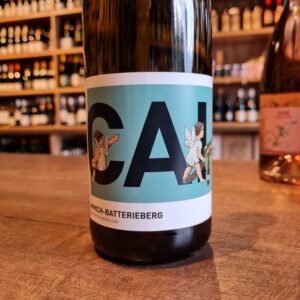 Immich-Batterieberg is one of the oldest wineries in the Mosel; originally founded by a Carolingian monastery, it can be traced back to the year 911. In 1495, the Immich family purchased the property, producing traditional dry and off-dry wines under their name for almost 500 years. The historical estate was then acquired in 2009 by Gernot Kollmann, one of Germany's finest up and comers. He is no stranger to the Mosel, having worked on many prestigious wineries in the region – Dr. Loosen, Weingut Van Volxem and Knebel. Since taking over, he has chosen to retain the long-standing tradition of the winery. The wines are once again produced in a dry or off-dry style, with sugar levels depending on each site, each vintage.80-percent of the vines are un-grafted and over 60 years old, and everything is worked organically. Intervention during vinification is also forbidden. A crisp, crunchy, keenly balanced, TOTALLY DRY trocken style Riesling.
Immich-Batterieberg is one of the oldest wineries in the Mosel; originally founded by a Carolingian monastery, it can be traced back to the year 911. In 1495, the Immich family purchased the property, producing traditional dry and off-dry wines under their name for almost 500 years. The historical estate was then acquired in 2009 by Gernot Kollmann, one of Germany's finest up and comers. He is no stranger to the Mosel, having worked on many prestigious wineries in the region – Dr. Loosen, Weingut Van Volxem and Knebel. Since taking over, he has chosen to retain the long-standing tradition of the winery. The wines are once again produced in a dry or off-dry style, with sugar levels depending on each site, each vintage.80-percent of the vines are un-grafted and over 60 years old, and everything is worked organically. Intervention during vinification is also forbidden. A crisp, crunchy, keenly balanced, TOTALLY DRY trocken style Riesling. -
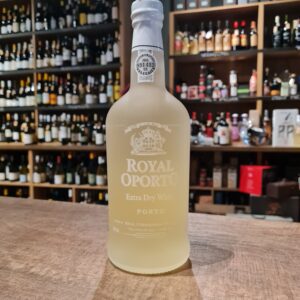 The Port is by difinition, generous and full-bodied wine, produced in the region Douro- the demarcated region of the world's oldest wines. Made from grapes traditionally used in the region, its wine making process is characterized by adding brandy to the wine in full fermentation. This type of port that inspires moments and new forms of consumption, which we recommend be served as Port Tonic. Classic serving would be as a chilled aperitif, but also you could be adventurous and make a ''Caipi Royal'' or just serve it on the rocks with an orange slice.
The Port is by difinition, generous and full-bodied wine, produced in the region Douro- the demarcated region of the world's oldest wines. Made from grapes traditionally used in the region, its wine making process is characterized by adding brandy to the wine in full fermentation. This type of port that inspires moments and new forms of consumption, which we recommend be served as Port Tonic. Classic serving would be as a chilled aperitif, but also you could be adventurous and make a ''Caipi Royal'' or just serve it on the rocks with an orange slice. -
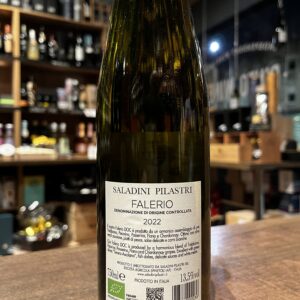
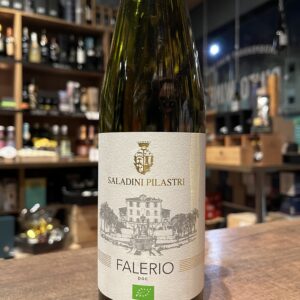 Saladini Pilastri is located in Spinetoli, in the Marche region of Italy . The history of the Counts Saladini Pilastri, a noble family from Ascoli Piceno, dates back to the early 1000s, but it is only for around 300 years that the family has been dedicated to wine production. Its 320 hectare wine estate is located in the heart of the Rosso Piceno production area. From the 1970s, new vines were planted; The current winery was built next to the splendid 15th century country house “Vigna Palazzi”, which originally served as a production site, so that all production could be kept in one place. The vineyard has been certified in organic farming since 1994. The climate here is Mediterranean, with hot, dry summers tempered by the maritime influence of the Adriatic Sea only 8km away from the vineyards. All the farming is organic and the winery is equipped with all the latest wine-making mod cons, helping speeding up the complex time of production and maintain quality. In true Italian style-Great wine with great food it helps that at the heart of the estate is a plush mansion house with a sweet swimming pool!. True quality of life. If I wasn't Portuguese, Italy would be where I would retire. Food-friendly as they come, its easy-going qualities match well with antipasti or even creamy pasta dishes but especially fish orientated dishes. Goditi il Vino!
Saladini Pilastri is located in Spinetoli, in the Marche region of Italy . The history of the Counts Saladini Pilastri, a noble family from Ascoli Piceno, dates back to the early 1000s, but it is only for around 300 years that the family has been dedicated to wine production. Its 320 hectare wine estate is located in the heart of the Rosso Piceno production area. From the 1970s, new vines were planted; The current winery was built next to the splendid 15th century country house “Vigna Palazzi”, which originally served as a production site, so that all production could be kept in one place. The vineyard has been certified in organic farming since 1994. The climate here is Mediterranean, with hot, dry summers tempered by the maritime influence of the Adriatic Sea only 8km away from the vineyards. All the farming is organic and the winery is equipped with all the latest wine-making mod cons, helping speeding up the complex time of production and maintain quality. In true Italian style-Great wine with great food it helps that at the heart of the estate is a plush mansion house with a sweet swimming pool!. True quality of life. If I wasn't Portuguese, Italy would be where I would retire. Food-friendly as they come, its easy-going qualities match well with antipasti or even creamy pasta dishes but especially fish orientated dishes. Goditi il Vino! -
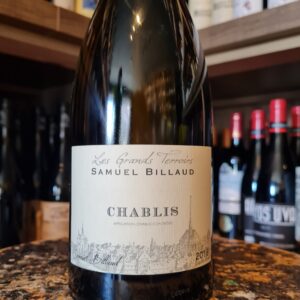 This excellent Chablis has a fine balance of ripe fruit and thrilling acidity. With a great length on the finish, it will develop with age in the cellar if you can keep your hands off it. Sourced from three parcels of vines in different sectors of the appellation; Les Pargues towards the village of Préhy, Les Cartes between the premiers crus of Vaillons and Montmains where the vines are 60 years old and Bas de Chapelots just below Montée de Tonnerre. Samuel Billaud is one of Chablis’ greatest winemakers. For twenty years he was responsible for the superb quality of wine at the family estate, Domaine Billaud-Simon, before setting up his own winery in 2009, where he produces a range of wines from several of the region’s finest sites. In 2014 he recovered his share of the Billaud-Simon vines which he now vinifies and bottles under his own name.
This excellent Chablis has a fine balance of ripe fruit and thrilling acidity. With a great length on the finish, it will develop with age in the cellar if you can keep your hands off it. Sourced from three parcels of vines in different sectors of the appellation; Les Pargues towards the village of Préhy, Les Cartes between the premiers crus of Vaillons and Montmains where the vines are 60 years old and Bas de Chapelots just below Montée de Tonnerre. Samuel Billaud is one of Chablis’ greatest winemakers. For twenty years he was responsible for the superb quality of wine at the family estate, Domaine Billaud-Simon, before setting up his own winery in 2009, where he produces a range of wines from several of the region’s finest sites. In 2014 he recovered his share of the Billaud-Simon vines which he now vinifies and bottles under his own name. -
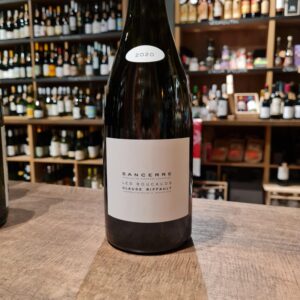 At barely 30 years old, Stephane Riffault (Claude’s son and now owner of the estate) is turning out Sancerre bottlings that are the envy of many producers twice his age. As David Schildknecht put it, “make no mistake: this address in the hamlet of Maison Salle (Sury-en-Vaux) is now one of the five or six most exciting estates in the Sancerre appellation.” Given that Stephane’s holdings represent 4 tenths of 1 percent of the appellation, this kid is clearly doing something right. Based in the village of Sury-en-Vaux, the domaine works 33 different parcels in 6 different lieu-dits spread across 4 villages. The 13.5 hectares of vines are plowed and no synthetic material is used. Unlike most Sancerre producers, the entire harvest is carried out by hand and an extensive sorting takes place before the grapes are crushed. Stephane’s wife, Benedicte, leads the harvest team while Stephane manages the sorting and press during harvest. Most of the domaine’s holdings are planted on the soft limestone soil called Terres Blanches with some parcels on calliottes and silex. Small, judicious uses of oak help to add length to the already precise and vertical bottling. All of the parcels are vilified separately and with the exception of the rose, all the wines are bottled unfiltered. Having studied and worked in Burgundy (and closely with Olivier Leflaive), it’s easy to see the Burgundian influence in Stephane’s wines. The mastery of minerality standing shoulder-height with the wood is rarely duplicated in Sancerre. Regardless of the exposition of his parcels (many are south-facing), Riffault’s wines are always crisp and high-cut with a jeweled sort of delineation that speaks to the precision and attention these wines get. These are not your daddy’s (or his daddy’s) Sancerres.
At barely 30 years old, Stephane Riffault (Claude’s son and now owner of the estate) is turning out Sancerre bottlings that are the envy of many producers twice his age. As David Schildknecht put it, “make no mistake: this address in the hamlet of Maison Salle (Sury-en-Vaux) is now one of the five or six most exciting estates in the Sancerre appellation.” Given that Stephane’s holdings represent 4 tenths of 1 percent of the appellation, this kid is clearly doing something right. Based in the village of Sury-en-Vaux, the domaine works 33 different parcels in 6 different lieu-dits spread across 4 villages. The 13.5 hectares of vines are plowed and no synthetic material is used. Unlike most Sancerre producers, the entire harvest is carried out by hand and an extensive sorting takes place before the grapes are crushed. Stephane’s wife, Benedicte, leads the harvest team while Stephane manages the sorting and press during harvest. Most of the domaine’s holdings are planted on the soft limestone soil called Terres Blanches with some parcels on calliottes and silex. Small, judicious uses of oak help to add length to the already precise and vertical bottling. All of the parcels are vilified separately and with the exception of the rose, all the wines are bottled unfiltered. Having studied and worked in Burgundy (and closely with Olivier Leflaive), it’s easy to see the Burgundian influence in Stephane’s wines. The mastery of minerality standing shoulder-height with the wood is rarely duplicated in Sancerre. Regardless of the exposition of his parcels (many are south-facing), Riffault’s wines are always crisp and high-cut with a jeweled sort of delineation that speaks to the precision and attention these wines get. These are not your daddy’s (or his daddy’s) Sancerres. -
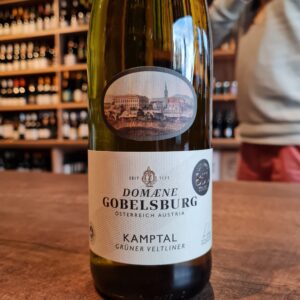 Like every vintage, the Grüner Veltliner Domain Gobelsburg is the benchmark wine in this price range, balanced, juicy and delicate, that's how Veltliner is fun. Delicate spice on the nose with some Boskop apple, Williams pear and herbaceous hints of thyme and mint. On the palate a rather soft texture, gentle fruit with a nice acidic accompaniment, delicately piquant pepper, then some minerality comes through. Again one of the most harmonious entry-level Veltliners of this vintage!
Like every vintage, the Grüner Veltliner Domain Gobelsburg is the benchmark wine in this price range, balanced, juicy and delicate, that's how Veltliner is fun. Delicate spice on the nose with some Boskop apple, Williams pear and herbaceous hints of thyme and mint. On the palate a rather soft texture, gentle fruit with a nice acidic accompaniment, delicately piquant pepper, then some minerality comes through. Again one of the most harmonious entry-level Veltliners of this vintage!


